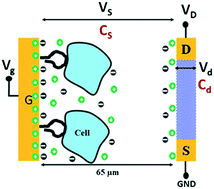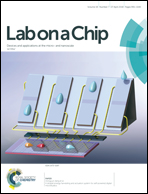Dynamic monitoring of transmembrane potential changes: a study of ion channels using an electrical double layer-gated FET biosensor†
Abstract
In this research, we have designed, fabricated and characterized an electrical double layer (EDL)-gated AlGaN/GaN high electron mobility transistor (HEMT) biosensor array to study the transmembrane potential changes of cells. The sensor array platform is designed to detect and count circulating tumor cells (CTCs) of colorectal cancer (CRC) and investigate cellular bioelectric signals. Using the EDL FET biosensor platform, cellular responses can be studied in physiological salt concentrations, thereby eliminating complex automation. Upon investigation, we discovered that our sensor response follows the transmembrane potential changes of captured cells. Our whole cell sensor platform can be used to monitor the dynamic changes in the membrane potential of cells. The effects of continuously changing electrolyte ion concentrations and ion channel blocking using cadmium are investigated. This methodology has the potential to be used as an electrophysiological probe for studying ion channel gating and the interaction of biomolecules in cells. The sensor can also be a point-of-care diagnostic tool for rapid screening of diseases.



 Please wait while we load your content...
Please wait while we load your content...